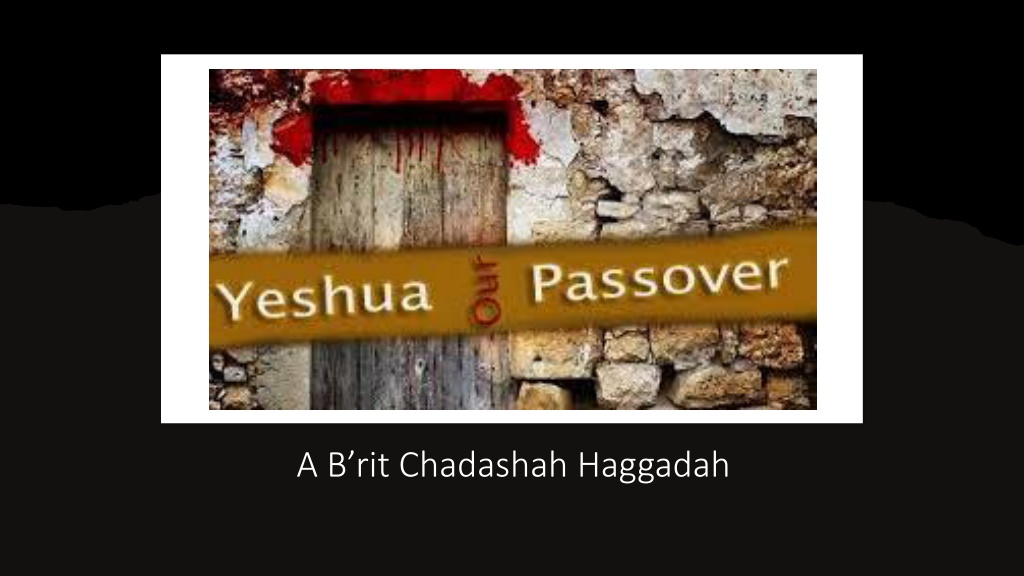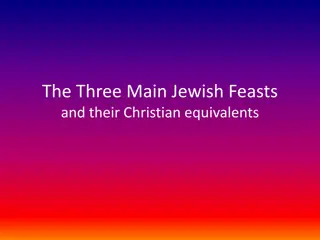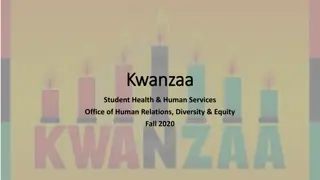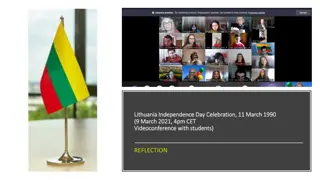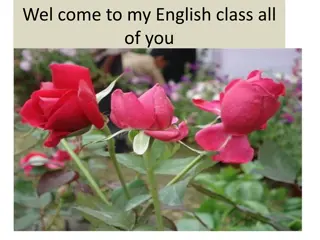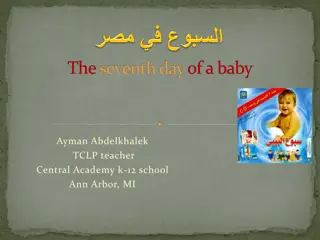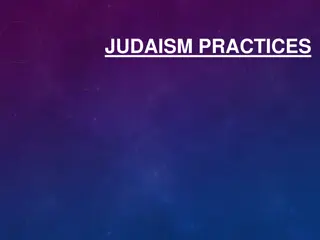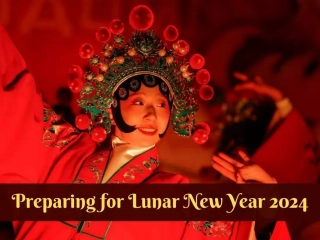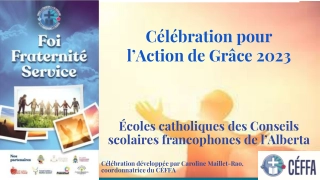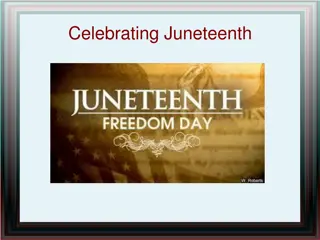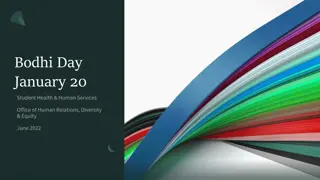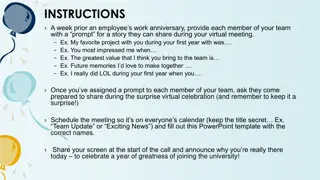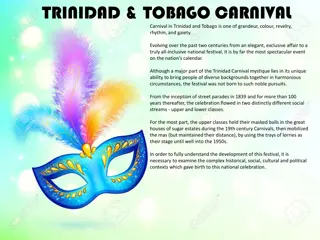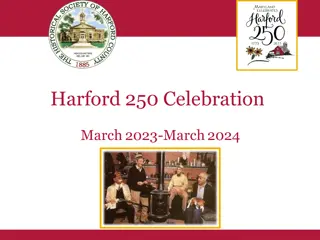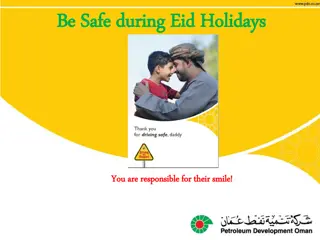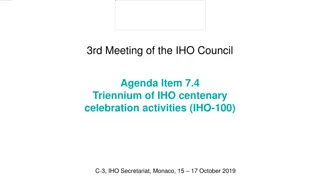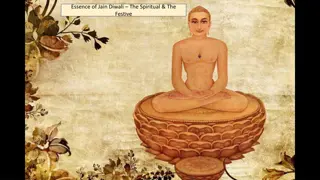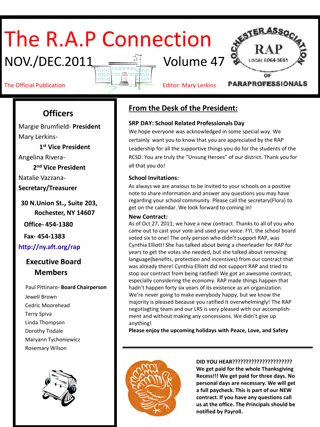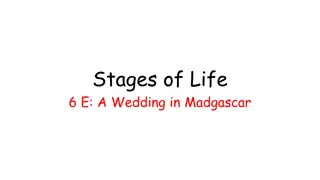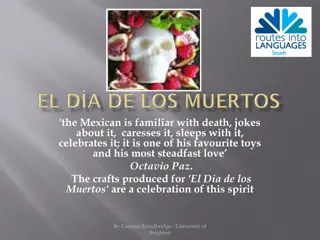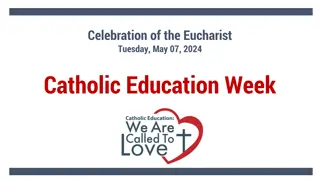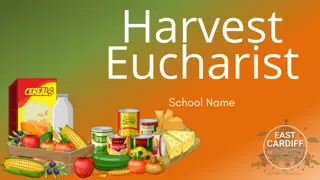A.Brit.Chadashah.Haggadah for Pesach Celebration
A guide for celebrating Pesach according to A.Brit.Chadashah Haggadah traditions, including essential items for the Seder, lighting of the candles, washing of hands, Kiddush, blessings, and the significance of Passover. The Haggadah emphasizes the covenant with Israel and the symbolism tied to the Pesach rituals.
Download Presentation

Please find below an Image/Link to download the presentation.
The content on the website is provided AS IS for your information and personal use only. It may not be sold, licensed, or shared on other websites without obtaining consent from the author. Download presentation by click this link. If you encounter any issues during the download, it is possible that the publisher has removed the file from their server.
E N D
Presentation Transcript
Items For Pesach 1. Shank Bone (only if possible) 2. Matzah 3. Wine/Grape Juice 4. Bitter Herb (parsley with small bowl of salt water to dip) 5. Charoset (https://www.hugforyourbelly.com/no-alcohol- charoset/) 6. Bitter herb (horseradish)
Birkat HaNer Lighting of the Candles Pesach, as commanded by YaHweh, is to be celebrated at home with family after all leaven has been removed from the household. Once the house and the participants are ceremonially clean, the Pesach Seder can begin. The woman of the house says a blessing and lights the Pesach candles. It is appropriate the woman brings light into the home, because it was through the woman that the light of the world, Messiah Yeshua, came into the world (Gen. 3:15; Luke 2:7).
Urchatz Washing of the Hands (Yochanan 13:1 11) Baruch a-tah YaHweh, Eloheynu Melech Ha-Olam, sha-mapshar lanu le-sha-tof ya-da-yim. Blessed are you, YaHweh our God, Master of the universe, who permits us to wash our hands (before eating food).
Kiddush First Cup: The Cup of Sanctification The Seder begins with a blessing recited over the first cup, the Cup of Sanctification (also called the Cup of Blessing). This first cup is meant to sanctify to set apart the rest of the evening as a holy occasion. One can fill the cup until it overflows, as in Jewish tradition a full cup is a symbol of joy. Pesach moves us to rejoice and celebrate YaH s goodness to His people. As a symbol of freedom. All fill the cup. All recite the blessing together:
Blessed are you Yahweh our Elohim, king of the universe, creator of the True fruit of the vine -Yeshua the Mashiach!
The Five Questions (for the children) 1) Why is the Celebration of Passover Special?
The Five Questions (for the children) Answer: Yahweh made a covenant with Israel. The Father also made a special covenant with all of us through his Son Yeshua the Messiah to bring salvation to the world.
The Five Questions (for the children) 2) Who is the Lamb in Passover?
The Five Questions (for the children) ANSWER: It represents deliverance and points us to Yeshua our Messiah
The Five Questions (for the children) 3) Why Does Yeshua need to die for us?
The Five Questions (for the children) ANSWER: To deliver us from slavery to sin, cleanse us from our sins and give eternal life
The Five Questions (for the children) 4) Why do we eat bitter herbs on Passover?
The Five Questions (for the children) ANSWER: The bitterness of slavery in Egypt and it shows how the bitterness of sin is in our life without Yeshua
The Five Questions (for the children) 5) Why do we eat Matzah?
The Five Questions (for the children) ANSWER: Leaven in bread represents sin in the body. Matzah is bread without leaven. No sin. It also points to Yeshua as sinless.
Tzafun (Means Hidden) Hiding the Afikoman The first step is to hide the middle piece of Matzah. Take three pieces of Matzah (each wrapped in a cloth or bag) and break the middle peace. Take the broken piece and hide it from the children. After the meal is finished, the leader of the Seder sends the children to find the afikoman. The child who finds it brings it to the leader of the Seder, who redeems the afikoman with a symbolic reward, usually some money or chocolate.
Surprisingly, Afikomen is not Hebrew, but a Greek word, the precise meaning of which is difficult to determine. But it comes from a verb -- afikomenos -- which, while a rare term, means HE IS COMING.
The Maggid (The Story) Welcome Chaverim (Brothers and sisters) Today we gather to keep the appointed time of YaH called Pesach and the Feast of Matzah. There are two reasons we celebrate this memorial. One is to remember what YaH did for Israel in the past. Second is what YaH will do for Israel and all believers in Yeshua in the future.
The Maggid (The Story) Let us first talk about the past. It all began when YaH made a covenant with Avraham and to his seed that he would give him prosperity, property and a people for all eternity. The blessing he would give Avraham and his seed would one day go out to all nations. YaH prophesied to Avraham his seed would be in slavery for 400yrs, but they would one day come out with great wealth (Bereishit/Genesis 12-17).
The Maggid (The Story) When the fullness of the prophecy came Avraham s seed had grown into twelve tribes by twelve sons who came from Avraham s grandson, Yaakov. Yaakov was given a new name by YaH which was Israel (which means Wrestled with God ). Later YaH raised up a man named Moshe to be the deliverer. The Malak of YaH (i.e., pre-incarnate Yeshua) came to Moshe and said, I am going to deliver my people from the bondage of slavery and use you to do it. Moshe fought it for a minute, but YaH convinced him he was the one He would use.
The Maggid (The Story) Moshe was sent to the Pharaoh of Egypt (who was the ruler of the most powerful empire in the world with the most powerful gods). Pharaoh resisted Moshe and YaHweh s request. Over the course of the next 8-9 months YaHweh reigned down his wrath on the gods of Egypt. YaH reigned havoc on the water source, crops, cattle and land through 6 strikes and 3 judgements, bringing Egypt to its knees. The final 10thblow came on Nisan 14 when YaH instituted the new feast called Pesach (Exodus 12).
The Maggid (The Story) On the last night before they deliverance one was to take a lamb for each household and offer it to YaH. The blood was to go on the doorpost and cross beam. The lamb was to be roasted over fire. This was called a Threshold Covenant in ancient times. The Malak of YaHweh would come through Egypt that night and any house without the blood, the first born, would be stuck down by the Malak of YaHweh (i.e, pre- incanate Yeshua).
The Maggid (The Story) The next morning all of Egypt would demand Israel to leave. It was on Nisan 15 Moshe lead Israel and a great mixed multitude of gentiles (who wanted freedom from slavery) out of Eypt (Shemot/Exodus 12:37-38). They would embark on a 50-day journey together to Mt. Sinai. Together they all would become the Israel of YaH (Shemot/Exodus 19-24).
Required Items on the Seder Plate (Shemot/Exodus 12:8-12)
Zeroah or Pesach (Lamb is optional because there is no Temple) The Lamb Shank bone The lamb shank bone is a symbol of the Temple offerings. It sits on the Pesach plate as a reminder of the first Pesach lamb sacrificed for the children of Israel, whose blood was applied to the lintel and doorposts of their homes. We raise the shank bone of the lamb and again remind ourselves of the lamb slain on behalf of the firstborn males among the Jewish people. Most importantly we remember Yeshua our Pesach Lamb who delivers us from the slavery of sin.
Bitter Herb (Parsley) Take the parsley and dip it in the salt water, representing the bitterness of slavery for Israel in Egypt. The salt water is for the tears shed by all slaves in Egypt.
Each person takes the parsley and dips it in the salt water. The following blessing is recited: Baruch Atah YaHweh Eloheinu Melech ha-Olam, asher kidshanu b mitsvotav v tsivanu al achi-lat mah-ror. Blessed are you YaHweh our God, King of the universe, who sanctified us with His commandments, and commanded us concerning the eating of the bitter herbs. All eat the parsley together.
Matzah or Matzot Matzah is the Hebrew word for Unleavened bread. This bread is commanded to be eaten for seven days. For seven days we cannot eat anything with leaven in it. Leaven represents sin in our lives. The command to remove all leaven from your house in Shemot/Exodus 12:15, helps to remind us to examine our hearts to see if any of us have hidden sin to confess to Yahweh and ask for forgiveness.
Matzah or Matzot Yeshua was the perfect Unleavened Bread (Matzah) because he was sinless and walked perfectly in this world. He qualified to be the spotless lamb offered to the Father to take away our sins if we commit our lives to following him (1 Cor. 5:7-8). The matzah tash is raised and the following blessing is recited.
Each person now breaks off a small piece of matzah and all recite the following blessing: Baruch Atah YaHweh Eloheinu Melech ha-Olam, asher kidshanu b mitsvotav v tsivanu al achilat m-tzah. Blessed are you YaHweh our God, King of the universe, who sanctified us with His commandments, and commanded us concerning the eating of unleavened bread. All eat together with the matzah.
Maror: Eating of the bitter herbs The maror (bitter herbs) reminds us of the bitterness of humankind s slavery to sin. It is tradition to dip one s matzah and take a heaping portion of the bitter herb, enough to make one shed a tear. Paul says 10 For I do not want you to be ignorant, brothers and sisters, that our fathers were all under the cloud and all passed through the sea. 2 They all were immersed into Moses in the cloud and in the sea. 3 And all ate the same spiritual food, 4 and all drank the same spiritual drink for they were drinking from a spiritual rock that followed them, and the Rock was Messiah (1 Cor 10).
Each person breaks an olive-sized piece of matzah and dips it in the bitter herbs. The following blessing is recited: Baruch Atah YaHweh Eloheinu Melech ha-Olam, asher kidshanu b mitsvotav v tsivanu al achi-lat mah-ror. Blessed are you YaHweh our God, King of the universe, who sanctified us with His commandments, and commanded us concerning the eating of bitter herbs. All eat the maror together.
Charoset: symbolizes the bricks of straw made by slaves in Egypt Take some matzah and put charoset on it to take and eat (recite the blessing). Baruch a-tah YaHweh, Eloheynu Melech Ha-Olam, sha-mapshar lanu al achi-lat char-o-set. Blessed are you, YaHweh our God, Master of the universe, who permits us concerning eating the charoset.
After the meal we now bring in the New Covenant (B rit Chadashah) Luke 22:7-8 Then came the day of matzah when the Passover lamb had to be sacrificed. 8 Now Yeshua sent Peter and John, saying, Go and prepare the Passover for us, so we may eat.
After the meal we now bring in the New Covenant (B rit Chadashah) Luke 22:14-16 When the hour came, Yeshua reclined at table, and the emissaries with Him. 15 And He said to them, I have eagerly desired to eat this Passover with you before I suffer. 16 For I tell you, I will never eat it again until it is fulfilled in the kingdom of God.
After the meal we now bring in the New Covenant (B rit Chadashah) Luke 22:17-20 and when He had taken a cup and offered the bracha, He said, Take this and share it among yourselves. 18 For I tell you that I will never drink the fruit of the vine from now on, until the kingdom of God comes. 19 And when He had taken matzah and offered the bracha, He broke it and gave it to them, saying, This is My body, given for you. Do this in memory of Me. 20 In the same way, He took the cup after the meal, saying, This cup is the new covenant in My blood, which is poured out for you.
After the meal we now bring in the New Covenant (B rit Chadashah) We take this moment to reflect upon the death of Yeshua for our sins, as He was the Lamb of God who takes away the sins of the world (Yochanan/John 1:29). This is a covenant fulfilling action. Only believers can partake of the bread and the wine. To take this in an unworthy manner is dangerous (1 Cor. 11:17-34). We explain to our children the nature of redemption and the need for the shedding of blood for all of us to experience forgiveness of sin (Lev. 17:11; Heb. 9:22).
After the meal we now bring in the New Covenant (B rit Chadashah)
HaGeulah 2nd Cup: Drink The Cup of The New Covenant (B rit Chadashah: Yirmayahu/Jeremiah 31:30-34)
HaGeulah 2nd Cup: Drink The Cup of The New Covenant (B rit Chadashah: Yirmayahu/Jeremiah 31:30-34, Psalm/Tehillah 116:12-14) Blessed are you Yahweh our Elohim, king of the universe creator of the TRUE fruit of the vine, Yeshua the Mashiach!
Tzafun (Means Hidden) Finding and Eating the Afikoman The leader of the Seder now sends the children to find the afikoman, which is the middle piece of matzah that was broken, wrapped in a napkin and hidden before the meal. The child who finds it brings it to the leader of the Seder, who redeems the afikoman with a symbolic reward, usually some money or chocolate.
Tzafun (Means Hidden) Finding and Eating the Afikoman According to tradition, the leader of the Seder then unwraps the afikoman, blesses it, and breaks it up into small olive- sized pieces. He then distributes a small piece to everyone seated around the table and all eat the afikoman together.
Tzafun (Means Hidden) Finding and Eating the Afikoman This tradition has not been found to be done in the first century. Evidence shows it was instituted sometime after the resurrection probably by believers in Yeshua. The first evidence we have of the tradition comes from a Jewish- Christian Bishop of the Assembly in Sardis in the late second century named Melito of Sardis, who knew the word afikoman as a Passover symbol for Yeshua. His sermon is dated
